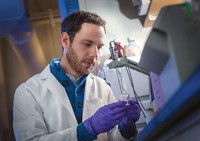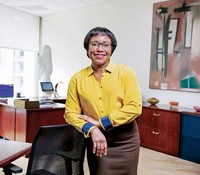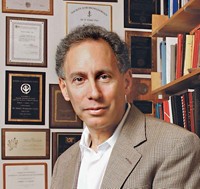Advertisement
Grab your lab coat. Let's get started
Welcome!
Welcome!
Create an account below to get 6 C&EN articles per month, receive newsletters and more - all free.
It seems this is your first time logging in online. Please enter the following information to continue.
As an ACS member you automatically get access to this site. All we need is few more details to create your reading experience.
Not you? Sign in with a different account.
Not you? Sign in with a different account.
ERROR 1
ERROR 1
ERROR 2
ERROR 2
ERROR 2
ERROR 2
ERROR 2
Password and Confirm password must match.
If you have an ACS member number, please enter it here so we can link this account to your membership. (optional)
ERROR 2
ACS values your privacy. By submitting your information, you are gaining access to C&EN and subscribing to our weekly newsletter. We use the information you provide to make your reading experience better, and we will never sell your data to third party members.
Biological Chemistry
Robert Langer Named Priestley Medalist
ACS Awards: MIT chemical engineer is honored for his influential work
by Stephen K. Ritter
June 13, 2011
| A version of this story appeared in
Volume 89, Issue 24
Robert S. Langer, the David H. Koch Institute Professor at Massachusetts Institute of Technology, has been selected to receive the 2012 Priestley Medal. Langer, 62, is being honored with the American Chemical Society’s most prestigious award in recognition of cutting-edge research that helped create the controlled-release drug industry and the field of tissue engineering.
“I’m honored—and a bit shocked—to receive the Priestley Medal,” Langer says. “It’s a thrill to be included among the prestigious winners of this award, not just for me, but for my lab, my fields of research, and for the chemical engineering community.”
To get a sense of Langer’s prolific career requires looking at a few numbers: He runs one of the largest academic laboratories in the world, with nearly 100 members. He has been an author of more than 1,100 research papers. He has approximately 800 issued and pending patents worldwide that have been licensed or sublicensed to more than 220 companies. And he has had a hand in creating some 25 companies.
“Professor Langer is a talented scientist who is motivated by a sense of responsibility to help people,” says longtime collaborator Joseph P. Vacanti, a tissue engineering expert and pediatric surgeon at Boston-based MassGeneral Hospital for Children. Langer is an affable person who manages to be thoughtful and gracious as he works to cross-pollinate ideas between different fields of research, Vacanti relates.
“He has an enormous gift of collaboration that gives him the ability to build successful research teams,” Vacanti says. “His pioneering work, in particular in slow-release medicines, has helped millions of people throughout the world.”

One of Langer’s first discoveries—and which he says is still a favorite—was that materials such as ethylene-vinyl acetate and lactic acid-glycolic acid copolymers could be dissolved, mixed with drugs, and made into materials that slowly release drugs into the body.
Another defining contribution was to change the way biomedical devices were developed. “Before we became involved, researchers were primarily clinicians who adapted off-the-shelf materials that resembled the tissue or organ they were working on,” Langer recalls. “We began to use chemistry and chemical engineering design principles to develop job-specific biomaterials.”
A third key contribution was helping start the field of regenerative medicine and tissue engineering to address the problem of donor-organ shortages. Langer and his colleagues, including Vacanti, figured out how to make degradable polymer scaffolds that could support growth of human cells, leading to artificial skin, muscles, nerves, cartilage, bone, and organs that are now used to treat patients.
Langer never seems to run out of ideas. His group’s most recent work includes contact lenses that release drugs and a polymer gel that can help people with damaged vocal cords get their voices back. His team is also reaching out in new directions, including developing substrate materials for improved growth of stem cells and lipid parcels called lipidoids to deliver short-interfering RNAs that can shut off malfunctioning genes that cause diseases.
“I have been astonished to see how successful Bob is at translating basic research findings into start-up companies without himself leaving the confines of academia,” says Cornell University organic chemist Bruce Ganem, who as cofounder of intellectual property development firm KensaGroup has worked closely with Langer. “His career provides the consummate example to aspiring scientist-entrepreneurs on how to combine academic research with the necessary translational firepower to turn inventions into innovative products,” Ganem says.

To name a few companies that have benefited from Langer’s ideas, Seventh Sense Biosystems has a needle-free microfluidic blood extraction process to transfer blood to a collection reservoir for immediate analysis; Alkermes uses controlled-release microspheres that deliver drugs and last much longer than a pill; MicroCHIPS develops implantable biochips with sensor-controlled arrays of microreservoirs that can be opened on demand to precisely control drug release; and BIND Biosciences uses engineered nanoparticles to selectively deliver drugs to tumor cells to increase efficacy and reduce chemotherapy side effects. To create these types of applications, Langer generally focuses on developing platform technologies that lead to multiple end points, rather than one-of-a-kind products, Langer says.
The successes haven’t spoiled Langer’s enthusiasm for what he is doing: following his dream upon leaving graduate school to use science as a tool to change the world in positive ways. “I love working with students and postdocs to dream up technologies and then take them from the blackboard to the marketplace,” Langer says. “There’s still a lot to be excited about.”






Join the conversation
Contact the reporter
Submit a Letter to the Editor for publication
Engage with us on Twitter